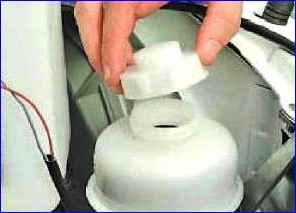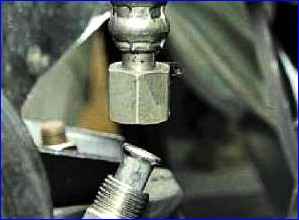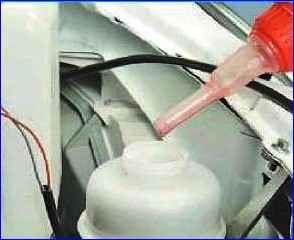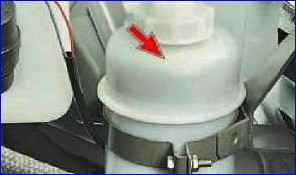Checking the level and adding fluid to the power steering reservoir
The reservoir is located on the left side of the engine compartment, next to the washer reservoir
Check the fluid level in the power steering pump reservoir.
It should be between the “MAX” and “MIN” marks marked on the tank body.
If the level is significantly lower, add fluid.

To do this, unscrew the tank cap.
Add working fluid to the required level
Wrap the plug
Replacing power steering fluid
The fluid in the power steering system must be replaced when it becomes dirty, and after 6 years of vehicle operation.

Keep the nut from turning and unscrew the pressure hose going to the steering mechanism.
Drain the fluid from the power steering system. Without starting the engine, turn the steering wheel in both directions from lock to lock until fluid stops flowing out of the hose.
Reconnect the hose to the pump and tighten the fitting to a torque of 44-62 Nm (4.4-6.2 kgcm).

Fill the system with fresh working fluid.
Start the engine. In this case, the liquid will go into the system.
Add fluid with the engine running until its level becomes constant.
Bleed the power steering system.
Bleeding the power steering system
We bleed the power steering system when air gets into the system during repair work related to depressurization of the system.
If there is air in the system, the steering becomes jammed when you try to make a sharp turn.
Also, the power steering pump makes increased noise when the steering wheel is turned, and the fluid in the reservoir foams.
To pump the system:
Pour working fluid into the power steering system
Brake with the handbrake, place stops under the rear wheels of the car.
Raise the front of the car.
Set the steering wheel to a straight position and start the engine.
Turn the steering wheel to the right until it stops. Air bubbles should appear in the tank.
Turn the steering wheel to the left until it stops.
If there is air left in the hydraulic system, air bubbles should appear in the reservoir.

Check and, if necessary, add fluid to the maximum mark.
We continue pumping until the working fluid enters the tank without air bubbles.
We install the car on the wheels and check the operation of the system.





